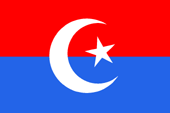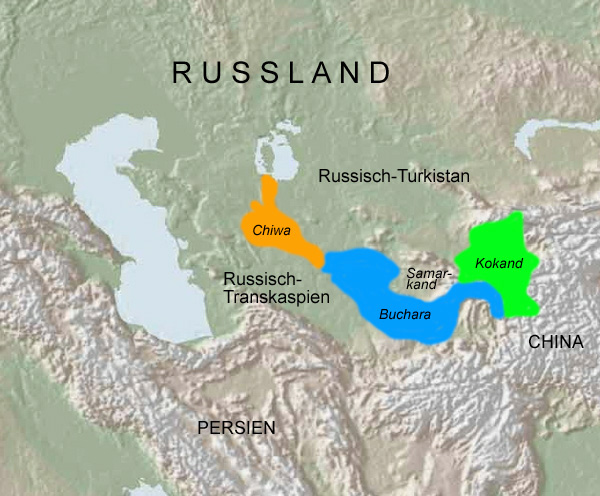mobile View, to the German Version tap the flag


- Chanate of Kokand
- former Turkestani state
- other names: Kokan, Khuqand, Farghana, Fergana
• Flags
• Meaning/Origin of the Flag
• Map
• Numbers and Facts
• History
• Origin of the Country's Name

18th–19th cent.,
Flag of the Chanate of Kokand,
Source, by: World Statesmen




1917–1920,
Flag of the Chanate of Kokand,
ratio = 2:3,
Source, by: World Statesmen




Kokand used a single-coloured red flag. Red is a flag color with a great tradition and wide dissemination in the islamic world, from Turkey over Turkestan to the coasts of Arabia, over Zansibar to the Maldives, which stands in dense context to the islam. Red flags had and have all islamic dynasties, which come from the Alawites (Alides, descentants of Ali) like today Morokko or former North Yemen, the Arabian Emirates and Oman. Moreover is red the colour of Omar, the second calif. In the short phase of the independence as an autonomous state was in use a horizontal striped red-blue flag with half-moon and star in the middle, the symbol of Islam but even of the Turks. Red is the traditional flag-colour of the country, blue is the colour of the Turk nations and Tatars.
Source:
World Statesmen, Volker Preuß

Turkistan about 1870:

Source: Freeware, University of Texas Libraries, modyfied by: Volker Preuß

Area: 38.610 square miles
Inhabitants: ca. 1.500.000 (1850, estimated value)
Capital: Kokand
official Languages: Uzbek, Turkmen
other Languages: Toijik, Kirghiz
Source:
World Statesmen,
Wikipedia (D)

antiquity · settlement by Iranian nations
5th century A.D. · immigration of Turk nations
8th century · Arabian conquest, islamization
10th–11th century · part of the Maverannah State (Transoxania) under the Samanids
11th century · conquest by the Selchuks
1220 · conquest by the Mongols under Dshingis Khan and his successors
14th century · invasions of Timur
8th of April 1369 · Timur becomes Emir of Transoxania with royal seat in Samarkand
1500 · conquest by the Uzbeks, to the Chanate of Bukhara
ca. 1710 · the Uzbek Shah-Rukh establishes the Chanate of Kokand by separation of Fergana Valley from the Chanate of Bukhara
1758 · Kokand becomes a vassal of China
1800–1826 · bigest deployment of power of the Chanate of Kokand
1841–1842 · conquest by Bukhara, the troops of Bukhara become indeed banished, but the country becomes a vassal of Bukhara
1865 · conquest and annexation of Tashkent by Russia
1868 · invasion by Russian troops, Kokand becomes a vassal of Russia
July 1875 · Hudayar Khan becomes banished, end of dynasty
19th of February 1876 · Russia annexes Kokand, incorporation into the General Gouvernement of Turkestan
1917 · bolshevist coup d’état in Russia
1917–1920 · civil war
11th of December 1917 · autonomous State of Kokand
1920 · conquest by troops of Soviet Russia, annexation to the Turkestanian Autonomous Soviet Republic
27th of October 1924 · annexation to Soviet Uzbekistan
5th of Dezember 1929 · parts of Fergana Valley become annexed to Soviet Tajikistan
Source:
World Statesmen,
Wikipedia (D),
Discovery '97

The name "Kokand" is derived from the same-named town. Sometimes the country was called after the landscape in which it is placed: "Fergana".
Source: Volker Preuß


![]()








